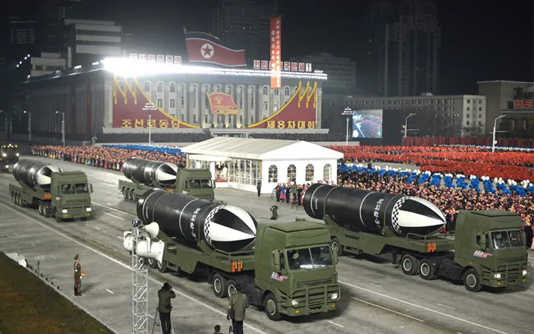SEOUL, Jan 15, 2021 (AFP) – Nuclear-armed North Korea unveiled a new
submarine-launched ballistic missile at a military parade in Pyongyang, state
media reported Friday, in a show of strength days before Joe Biden’s
inauguration as US president.
The display came after the five-yearly congress of the ruling Workers’
Party, where leader Kim Jong Un decried the US as his country’s “foremost
principal enemy”.
A grinning Kim oversaw the parade on Thursday evening, wearing a black
leather coat and fur hat as he watched infantry troops, artillery, tanks, and
a flypast with aircraft forming the number “8” to commemorate the party
meeting.
“The world’s most powerful weapon, submarine-launch ballistic missile,
entered the square one after another, powerfully demonstrating the might of
the revolutionary armed forces,” the official KCNA news agency said.
Pictures showed at least four of the SLBMs with black-and-white cones being
driven past flag-waving crowds in Kim Il Sung Square, and Park Won-gon of
Handong Global University in the South described them as “the North’s
ultimate nuclear weapon”.
The North has shown off earlier, smaller SLBMs before, and broadcast
footage of a test launch, but it was not clear whether that missile was fired
from a submarine or an underwater platform.
A working SLBM on a nuclear-powered submarine would be a strategic game-
changer, enabling Pyongyang to launch a surprise attack from close to the
United States or carry out a strike even if its land-based forces had been
destroyed.
At the congress, Kim said the North had completed plans for a nuclear
submarine, but any such vessel is likely to be years away from going into
service.
Analysts say the North is using the party meeting and military display to
send the incoming administration in Washington a carefully calibrated message
of strength in an attempt to extract concessions.
KCNA said the parade included rockets with a “powerful striking capability
for thoroughly annihilating enemies in a preemptive way outside the
territory” — implying a range extending beyond the Korean peninsula.
Images showed the display culminating with what appeared to be a new solid-
fuel short-range ballistic missile — which are more mobile and more quickly
deployed than liquid-fuelled versions.
“They’d like us to notice that they’re getting more proficient with larger
solid rocket boosters,” tweeted Ankit Panda of the Carnegie Endowment.
But Pyongyang did not appear to put on show any of its intercontinental
ballistic missiles (ICBMs), unlike at its previous parade in October, when it
revealed a huge new ICBM on an 11-axle vehicle that analysts said was the
largest road-mobile, liquid-fuelled missile in the world.
“The majestic elite units and invincible iron-clad ranks of the Republic
which will proudly pass Kim Il Sung Square represent our absolute power,”
North Korean defence minister Kim Jong Gwan said in a speech ahead of the
Thursday evening parade, KCNA reported.
– ‘Well-calculated’ –
Kim and Donald Trump had a tumultuous relationship, engaging in mutual
insults and threats of war before an extraordinary diplomatic bromance
featuring headline-grabbing summits and declarations of love by the outgoing
US president.
But little substantive progress was made, with the process deadlocked after
a February 2019 summit in Hanoi broke down over sanctions relief and what
Pyongyang would be willing to give up in return.
The North is under multiple sets of international sanctions over its banned
nuclear weapons and ballistic missile programmes, which have made rapid
progress under Kim and which it says it needs to defend itself against a
possible US invasion.
At the same time, it is under a self-imposed coronavirus blockade, having
closed its borders last January to protect against the virus that first
emerged in neighbouring China, adding to the pressure on its moribund
economy.
And the change of US leadership presents a challenge for Pyongyang. Biden
is associated with the Obama administration’s “strategic patience” approach
and characterised Kim as a “thug” during the presidential debates.
Washington is expected to return to more orthodox diplomatic approaches
under Biden, such as insisting on extensive progress at working-level talks
before any leaders’ summit can be considered.
“It was very well calculated,” professor Park told AFP. “Without showing
any ICBMs, Kim Jong Un still sent a message on the North’s nuclear
capabilities and military strengths.
“Kim is saying if the incoming Biden administration does not remove its
‘hostile policies’ against the North, to the degree that Kim wants, this is
the path that the North is willing to take.”



